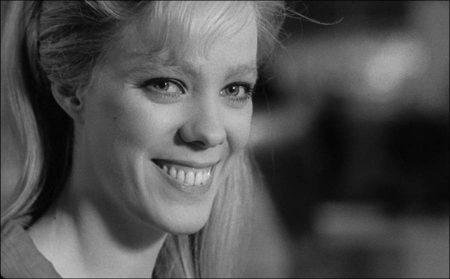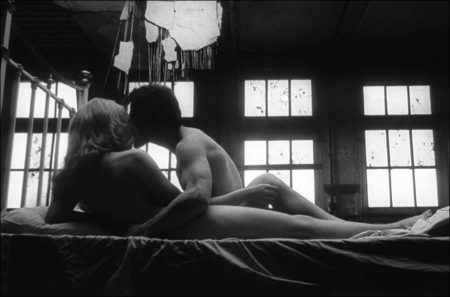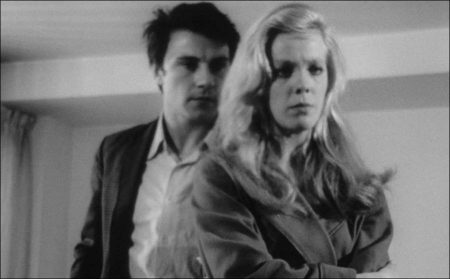Who’s That Knocking at My Door movie storyline. J.R. is a typical Catholic Italian-American young man on the streets of New York City. Even as an adult, he stays close to home with a core group of friends with whom he drinks and carouses around. He gets involved with a local girl he meets on the Staten Island Ferry, and decides he wants to get married and settle down. As their relationship deepens, he declines her offer to have sex because he thinks she is a virgin and he wants to wait rather than “spoil” her.
One day, his girlfriend tells him that she was once raped by a former boyfriend. This crushes J.R., and he rejects her and attempts to return to his old life of drinking with his friends. However, after a particularly wild party with friends, he realizes he still loves her and returns to her apartment one early morning.
He awkwardly tells her that he forgives her and says that he will “marry her anyway.” Upon hearing this, the girl tells him marriage would never work if her past weighs on him so much. J.R. becomes enraged and calls her a whore, but quickly recants and says he is confused by the whole situation. She tells him to go home, and he returns to the Catholic church, but finds no solace.
Who’s That Knocking at My Door, originally titled I Call First, is a 1967 American independent drama film written and directed by Martin Scorsese and starring Harvey Keitel and Zina Bethune. It was Scorsese’s feature film directorial debut and Keitel’s debut as an actor. Exploring themes of Catholic guilt similar to those in his later film Mean Streets, the story follows Italian-American J.R. (Harvey Keitel) as he struggles to accept the secret hidden by his independent and free-spirited girlfriend (Zina Bethune).
Who’s That Knocking at My Door was filmed over the course of several years, undergoing many changes, new directions and different names along the way. The film began in 1965 as a student short film about J.R. and his do-nothing friends called Bring on the Dancing Girls. In 1967, the romance plot with Zina Bethune was introduced and spliced together with the earlier film, and the title was changed to I Call First. This version of the film received its world premiere at the Chicago International Film Festival in November 1967.
Finally, in 1968, exploitation distributor Joseph Brenner offered to buy the picture and distribute it on the condition that a sex scene be added to give the film sex exploitation angles for marketing purposes.[1] Scorsese shot and edited a technically beautiful but largely gratuitous montage of J.R. fantasizing about bedding a series of prostitutes (shot in Amsterdam, the Netherlands with a visibly older Keitel) and the film finally became Who’s That Knocking at My Door (named for the 1959 song by The Genies which closes the film).[3] The film was then re-issued under the title J.R. in 1970,[4] however all subsequent releases have been published under the 1968 title.
The film was shot with a combination of 35 mm and 16 mm cameras. Scorsese shot most of the 35 mm footage with a Mitchell BNC camera, a very cumbersome camera that impeded mobility. He opted to shoot several scenes with the 16 mm Eclair NPR camera in order to introduce greater mobility, then blow up the footage to 35 mm.
Film Review for Who’s That Knocking at My Door
There has been a long wait for an American film like Martin Scorsese’ s “I Call First,” which made a stunning impact in its world premiere Wednesday night at the Chicago International Film Festival. As a film, it has something to say to everyone. As a technical achievement, it brings together two opposing worlds of American cinema.
On the one hand, there have been traditional films like “Marty,” “View from the Bridge,” “On the Waterfront” and “David and Lisa” — all sincere attempts to function at the level where real lives are led and all suffering to some degree from their makers’ romantic and idealistic ideas, about such lives.
On the other hand there have been experimental films from Jonas Mekas, Shirley Clarke and other pioneers of the New York underground. In “The Connection,” “Shadows” and “Guns of the Trees,” they used improvised dialog and scenes and hidden and hand-held cameras in an attempt to capture the freshness of a spontaneous experience.
Both groups have lacked the other’s strong point. The films like “Marty” are technically well done and emotionally satisfying, but they lack the flavor of actual experience. Films like “Shadows” are authentic enough, but often poor in technical quality and lacking the control necessary to develop character and tell a story.

“I Call First” brings these two kinds of films together into a work that is absolutely genuine, artistically satisfying and technically comparable to the best films being made anywhere. I have no reservations in describing it as a great moment in American movies.
Remarkably, writer-director Martin Scorsese is only 25 years old, and this is his first film. He tells a love story about two different kinds of people. His young man is from New York’s “Little Italy,” has a strong Roman Catholic background, is intelligent but not very well-educated and divides the women of the world into “nice girls” and “broads.” The young woman is a college graduate, well read, more sophisticated and has probably had an affair or two. She loves him enough to try to explain that she is a “nice girl” but not a virgin.
The divergent views of love and morality come into opposition, but they make a tremendous effort to understand and respect each other. In the end, they fail. Their story is told against a poetically evoked background of the young man’s life with his friends, who were probably his high school and army buddies and will probably be his old age cronies. Two scenes — one in a bar, another at a party — are among the most evocative descriptions of American life I have ever seen.
I want to comment at length on the performances and details of the plot, but I will have to wait until the film begins its commercial run here. I hope that will be soon.
Who’s That Knocking at My Door (1967)
Directed by: Martin Scorsese
Starring: Harvey Keitel, Zina Bethune, Anne Collette, Lennard Kuras, Michael Scala, Harry Northup, Tsuai Yu-Lan, Saskia Holleman, Bill Minkin, Wendy Russell, Philip Carlson, Susan Wood, Marrissa Joffre, Catherine Scorsese
Screenplay by: Martin Scorsese
Production Design by: Barbara Battle
Cinematography by: Michael Wadley, Richard Coll
Film Editing by: Thelma Schoonmaker
Art Direction by: Victor Magnotta
MPAA Rating: None.
Distributed by: Joseph Brenner Associates
Release Date: November 15, 1967 (Chicago)
Views: 313



